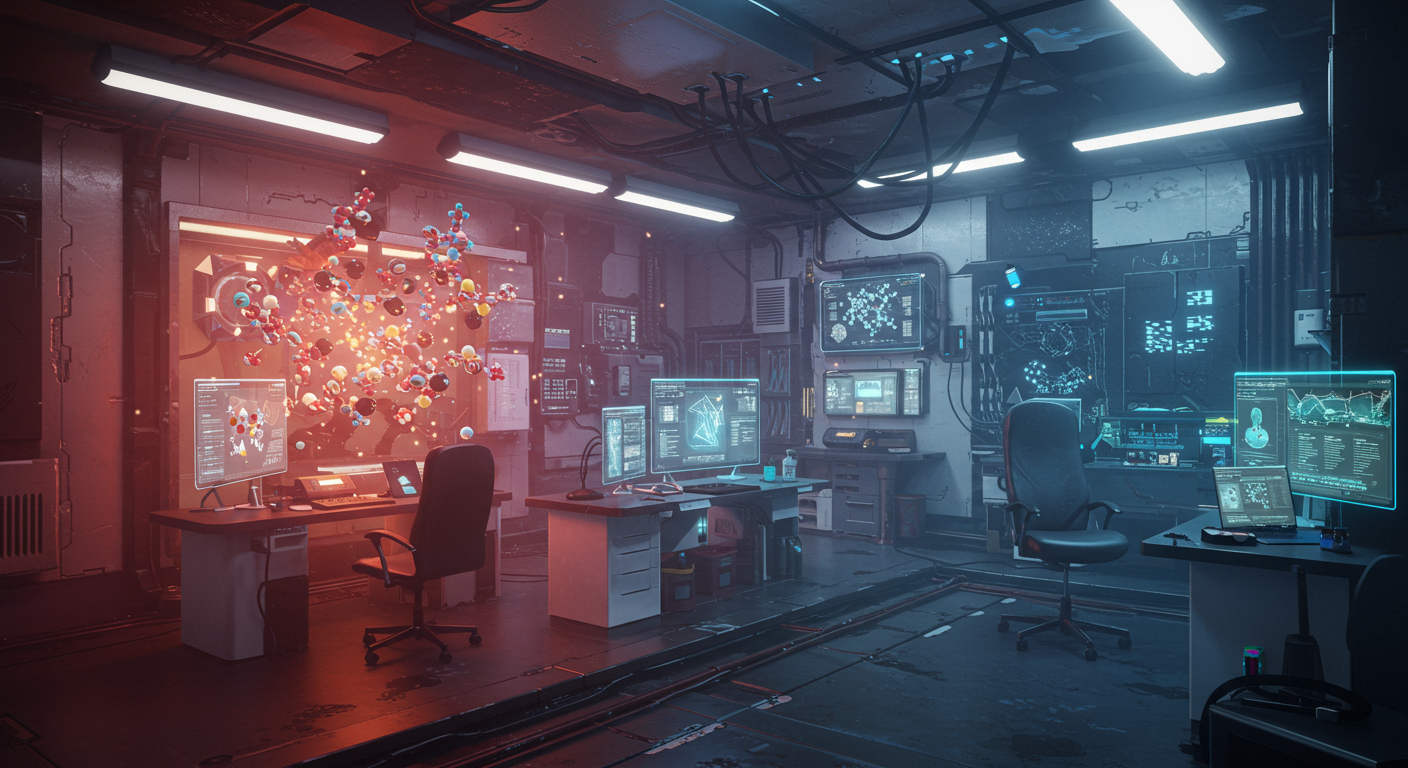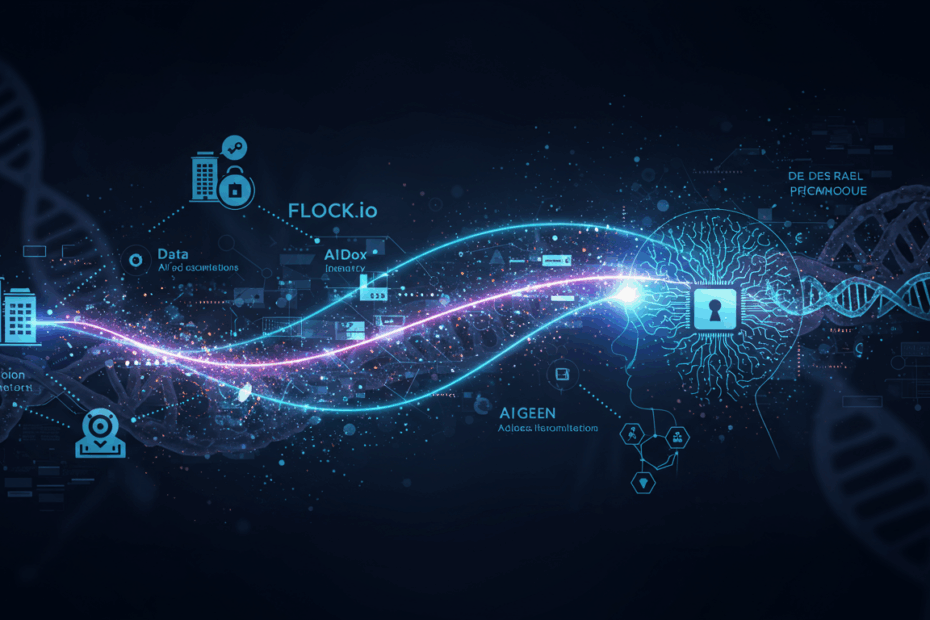Unlocking Cures Without Compromising Code: A Deep Dive into FLock.io and AIGEN Sciences
John: In the world of tech, we often chase the next big thing—smarter phones, faster networks, more immersive virtual worlds. But every now and then, a collaboration emerges that aims for something far more profound. Today, we’re looking at one such alliance: the partnership between FLock.io and AIGEN Sciences. They’re tackling one of humanity’s biggest challenges, drug discovery, by using a powerful combination of artificial intelligence and decentralized technology.
Lila: That sounds massive, John. So we’re not just talking about a new app or gadget; this is about revolutionizing medicine. When I hear “AI and drug discovery,” I picture scientists in lab coats working with supercomputers. But you mentioned “decentralized technology.” How does that fit in, and why is this partnership getting so much attention?
John: That’s the perfect question to start with, Lila. The ‘decentralized’ part is the secret sauce. Traditionally, AI in medicine has a huge Achilles’ heel: data privacy. To train a powerful AI, you need vast amounts of sensitive patient data from hospitals and research institutions. But these organizations are, quite rightly, fiercely protective of that data. The partnership between FLock.io and AIGEN Sciences aims to solve this very problem, potentially unlocking a new era of biomedical research without forcing anyone to share their raw data. It’s a paradigm shift.

Basic Info: Who Are the Players?
Lila: Okay, let’s break it down. Who exactly are FLock.io and AIGEN Sciences? Are they established giants or innovative startups?
John: They are both on the cutting edge, but from slightly different angles. Think of them as two specialists combining their expertise.
- FLock.io (Federated Learning on Chain) is the technology backbone. They are building a decentralized, privacy-preserving AI training infrastructure. Their focus is on the ‘how’—creating a system where AI models can be trained without centralizing the data.
- AIGEN Sciences is the domain expert. They are a startup focused on applying generative AI to drug discovery. Their strength is in the ‘what’—understanding the biological and chemical challenges of creating new medicines and building AI models to tackle them.
In essence, AIGEN builds the brilliant student (the AI model), and FLock creates the perfect, privacy-first university (the decentralized training network) for that student to learn in.
Lila: I like that analogy! So AIGEN has the AI brains for medicine, but those brains need to learn from books they can’t take out of the library. FLock.io has invented a way for the AI to read the books right there in the library, without ever removing them. Is that close?
John: That’s an excellent way to put it, Lila. It perfectly captures the core concept. The “libraries” in this case are hospitals, research labs, and pharmaceutical companies, and the “books” are their invaluable and highly sensitive datasets.
Supply Details: Fueling the AI Engine
Lila: You mentioned data is the fuel. In crypto, we talk about token supply and distribution. What does the ‘supply’ look like here? Is it about data, computing power, or something else?
John: Precisely. The “supply” in this ecosystem isn’t a cryptocurrency, but rather the essential components needed for the AI to function and grow. The supply chain has three main pillars:
- Data Supply: This is the most critical element. It comes from various partners who hold biomedical data. We’re talking about genomic data, patient records, clinical trial results, and molecular structures. The key is that these suppliers—hospitals, universities, biotech firms—can contribute to the collective intelligence without their raw data ever leaving their own secure servers.
- Model Supply: AIGEN Sciences is the initial and primary supplier of the AI models. They design the sophisticated algorithms, like their generative AI discovery engine, that are purpose-built for tasks like identifying new drug candidates or predicting a compound’s effectiveness. In the future, other researchers could potentially contribute their own models to the platform.
- Computational Supply: Training these complex AI models requires immense computing power. FLock.io’s decentralized infrastructure coordinates this. The ‘computation’ happens locally on the data provider’s side. So, a hospital, for instance, would use its own computational resources to train the model on its data, ensuring maximum security.
So, the system isn’t fueled by a token sale, but by a collaborative supply of data, intelligence, and processing power.
Lila: That makes a lot of sense. So data holders are incentivized because they get to be part of groundbreaking research and potentially benefit from the discoveries, all without the massive security risk of sending their data somewhere else. They ‘contribute’ by letting the AI model come to them. It’s a win-win.
The Technical Mechanism: How Does it Actually Work?
John: Now we get to the heart of the innovation. The technology that makes this possible is called Federated Learning. It’s a concept that’s been around for a bit, famously used by companies like Google to improve keyboard predictions on your phone without reading your texts. FLock.io is taking this concept and decentralizing it further with blockchain technology.
Lila: Federated Learning… that sounds complex. Can you walk me through it step-by-step? Imagine I’m a hospital that wants to participate. What happens?
John: Absolutely. Here’s a simplified breakdown of the process from the hospital’s perspective:
- Step 1: Receive the Global Model. The process starts with a “global” AI model, designed by AIGEN Sciences. This initial model is like a freshman student—it knows the basics of biology and chemistry but has no real-world experience. FLock.io’s platform sends a copy of this model to your hospital and other participating institutions.
- Step 2: Local Training. Your hospital’s servers then train this copy of the model using your private, local patient data. The AI learns from your data—identifying patterns, connections, and anomalies—but all of this happens securely behind your firewall. Your data never moves.
- Step 3: Generate an Update, Not Data. Once the local training is complete, the model has become “smarter.” It has learned specific insights from your dataset. Instead of sending any of that sensitive data back, your system generates a summary of what the model learned—an anonymized “model update.” Think of it as sending back just the “lessons learned” or the cliff notes, not the entire textbook.
- Step 4: Secure Aggregation. FLock.io’s decentralized platform securely collects these anonymized model updates from all participating institutions. It then intelligently combines, or “aggregates,” all these lessons to improve the central global model.
- Step 5: A Smarter Global Model. This newly improved global model—now a sophomore or junior student—is sent back out to all participants for the next round of training. This cycle repeats, with the AI getting progressively more intelligent and accurate with each iteration, having learned from a diverse global dataset without ever seeing it directly.
Lila: Wow. So the data stays put, and only the learning gets shared. But you mentioned FLock.io uses blockchain. Where does that come in?
John: An astute question. The blockchain, or more accurately, a decentralized ledger, serves as the trust layer. It plays a few crucial roles:
- Coordination and Orchestration: The ledger acts as an immutable (unchangeable) record keeper. It logs which model version was sent to which participant and when they submitted their update. This creates a transparent and auditable trail of the entire training process.
- Incentive and Reward Mechanisms: While not a direct payment system in the traditional crypto sense, the on-chain component can be used to track contributions. It can verify that a hospital provided a valid update, creating a basis for future reward models, whether through data-sharing agreements, access to research findings, or other benefits.
- Security and Integrity: By decentralizing the aggregation process, you remove a single point of failure. It ensures that no single entity, not even FLock.io itself, can tamper with the model updates or manipulate the learning process. It’s a system built on verifiable, distributed trust.
This is what “Federated Learning on Chain” really means. It’s the privacy of federated learning combined with the transparency and security of blockchain.
Lila: So the blockchain is like the registrar’s office and the security guard for the whole “privacy-first university” you mentioned earlier. It makes sure everyone is playing by the rules and that the final ‘diploma’ the AI receives is legitimate. That’s brilliant.

Team & Community: The Minds Behind the Mission
John: Technology is only as good as the people building it, and this is where the FLock/AIGEN partnership really shines. The teams bring a huge amount of credibility. A key figure associated with AIGEN Sciences is Professor Jaewoo Kang of Korea University.
Lila: Jaewoo Kang… that name sounds familiar. Why is he significant?
John: He’s a heavyweight in the field of bioinformatics (the science of collecting and analyzing complex biological data). Professor Kang is internationally recognized for co-developing BioBERT. BERT is a revolutionary AI language model from Google, and BioBERT is a specialized version pre-trained on a massive corpus of biomedical scientific literature. It can understand the language of biology and medicine better than almost any other AI. His involvement lends immense scientific and technical weight to AIGEN’s efforts.
Lila: So, the person who taught an AI to read and understand millions of medical papers is now involved in a company that uses AI for drug discovery. That’s a huge vote of confidence. What about the FLock.io team?
John: The FLock.io team is comprised of experts in decentralized systems, cryptography, and machine learning. Their CEO, Jiahao Sun, has a strong background in building scalable decentralized platforms. The FLock Foundation, the non-profit entity guiding the project, is focused on fostering an open-source, collaborative ecosystem. Their vision isn’t just to build a product, but to create a standard for privacy-preserving AI.
Lila: What about the community? Is this just for big corporations and hospitals, or can smaller research groups or even individual developers get involved?
John: That’s the long-term vision. While the initial partnerships, like the one with AIGEN, are with established players to prove the model, the goal of a decentralized platform is to open up access. In the future, one could imagine a permissionless system where smaller labs could contribute their niche datasets or AI developers could submit their models for training on the network. Building that community is a critical next step after validating the core technology with major partners.
Use-Cases & Future Outlook: From Code to Cures
John: The primary use case is clear and incredibly ambitious: to dramatically accelerate the drug discovery pipeline. This process traditionally takes over a decade and costs billions of dollars, with a very high failure rate. AI can help at several stages.
Lila: How exactly? Can the AI just invent a new drug from scratch?
John: Not quite “invent” in the human sense, but it can find needles in haystacks at superhuman speed. Here’s where AIGEN’s models, trained via FLock’s network, could make a difference:
- Target Identification: Identifying the specific biological molecules (like a faulty protein) in the body that a new drug should target. The AI can analyze vast genomic and proteomic datasets to find the most promising targets.
- Hit-to-Lead Generation: After finding a target, scientists need to find a molecule (a ‘hit’) that can interact with it. Generative AI can design and screen millions of potential drug compounds virtually, predicting which ones are most likely to be effective and have minimal side effects, long before they are synthesized in a lab.
- Clinical Trial Optimization: AI can analyze patient data to predict which individuals are most likely to respond to a particular drug. This could lead to smaller, faster, and more successful clinical trials.
Lila: That’s incredible. So it’s not just about one magic moment of discovery, but about making every single step of a very long and expensive journey faster and smarter. The future outlook, then, isn’t just about the tech itself, but the real-world impact—new medicines for diseases that are currently untreatable?
John: Exactly. The ultimate goal is to shorten the timeline from identifying a disease mechanism to having an effective treatment in the hands of patients. Beyond drug discovery, this same privacy-preserving federated learning framework could be applied to other areas of medicine, like personalized treatment plans, diagnostic imaging analysis, and outbreak prediction. The potential is vast. This is about creating a secure data collaboration economy for healthcare.

Competitor Comparison: A Crowded Field?
Lila: This sounds so revolutionary, but are they the only ones doing this? Who are the competitors?
John: It’s a growing field, but the competition is fragmented. We can group them into two main categories.
First, you have the centralized AI drug discovery companies. These are big names like BenevolentAI or Exscientia, which are also using AI to discover drugs. They are very successful but often operate on a more traditional model. They form partnerships to get access to data, but it’s typically housed centrally, which can be a bottleneck and raises the very privacy concerns we’ve discussed.
Lila: So their approach is, “Trust us with your data, and we’ll produce results.”
John: Correct. The second category is other decentralized AI or data-sharing platforms. Projects like Ocean Protocol are building general-purpose decentralized data marketplaces, and others are exploring federated learning. However, the unique advantage of the FLock.io and AIGEN Sciences partnership is its razor-sharp focus. They aren’t just building a general tool; they are building a specific, end-to-end solution for a single, high-value problem: drug discovery. FLock provides the specialized, on-chain federated learning infrastructure, and AIGEN provides the world-class, purpose-built AI models. This synergy is their key differentiator.
Lila: So one group has the AI expertise but a centralized model, and another group has the decentralized tools but not necessarily the specialized medical AI. This partnership brings both critical pieces together from day one. That makes their value proposition very clear.
Risks & Cautions: Navigating the Hurdles
John: As with any groundbreaking technology, it’s crucial to be realistic about the challenges. This is not a guaranteed home run. There are significant risks and hurdles to overcome.
Lila: What keeps you up at night when you think about this? What could go wrong?
John: I’d point to three main areas of caution:
- Regulatory and Compliance Hurdles: Healthcare data is one of the most heavily regulated sectors in the world. They will need to navigate a maze of regulations like HIPAA (in the US) and GDPR (in Europe). While federated learning is designed for privacy, proving its compliance to skeptical regulators and institutional review boards will be a slow and painstaking process.
- Data Quality and Standardization: The principle “garbage in, garbage out” is especially true for AI. The success of the entire system depends on the quality and consistency of the data from different institutions. If hospitals record data in different formats or with varying degrees of accuracy, it can corrupt the learning process. Establishing a common standard without centralizing the data is a major technical and logistical challenge.
- Technical Scalability and Security: While federated learning protects raw data, there are still theoretical security risks, such as “model inversion” attacks where an adversary tries to reverse-engineer private data from the model updates. FLock.io will need to be constantly at the forefront of cryptographic research to counter these threats. Furthermore, scaling this process across hundreds of global institutions with varying IT capabilities is a monumental task.
Lila: So even if the tech works perfectly in a lab, making it work in the real, messy world of global healthcare is the real test. And patients need to be sure that “almost private” isn’t a thing—it has to be completely secure.
John: That’s the bottom line. The trust of both the data providers and the public is paramount. One slip-up could be catastrophic for the project’s reputation. They are walking a tightrope, but the potential reward on the other side is immense.
Expert Opinions / Analyses
John: The initial reaction from the tech and biomedical communities has been very positive, albeit cautiously optimistic. News outlets that cover the intersection of AI and Web3, like mpost.io and Korea IT Times, were quick to pick up the announcement of their Memorandum of Understanding (MOU).
Lila: What’s the general sentiment in those articles?
John: The consensus is that this alliance directly addresses a critical bottleneck. A report in mpost.io highlighted that the partnership “aims to overcome data privacy barriers in biomedical AI.” This framing is key. It’s seen not just as an interesting tech experiment, but as a targeted solution to a well-known industry problem. The Korea IT Times emphasized the practical application, stating the goal is to “deploy privacy-preserving AI in Drug Discovery.” The focus is on deployment and real-world application, not just theory.
Lila: So the experts aren’t just saying the tech is cool; they’re saying this is a smart business and scientific strategy. They see the problem and recognize this as a credible attempt to solve it.
John: Precisely. The involvement of respected figures like Professor Kang also lends the project a level of scientific legitimacy that many tech–first projects lack. Analysts see the combination of AIGEN’s deep domain expertise with FLock’s robust, privacy-centric infrastructure as a powerful and well-thought-out strategy. The question on everyone’s mind is no longer “is this a good idea?” but rather “can they execute it?”
Latest News & Roadmap
John: The most significant recent news, and the catalyst for our discussion today, is the signing of the Memorandum of Understanding (MOU) between FLock.io and AIGEN Sciences Inc. This was formally announced across their platforms, including X (formerly Twitter) and LinkedIn.
Lila: An MOU is basically a formal agreement to work together, right? A public statement of intent?
John: Exactly. It solidifies the partnership and signals to the industry that they are moving forward together. It’s the starting gun for the collaboration. In terms of a roadmap, the steps will likely follow a logical progression from this MOU.
- Phase 1: Integration. The immediate next step is the technical work of connecting FLock.io’s on-chain federated learning infrastructure with AIGEN’s drug discovery engine. This is the groundwork.
- Phase 2: Pilot Projects. They will need to run pilot studies with a small, select group of research and hospital partners. This will be to test the system in a controlled, real-world environment, work out the kinks, and gather data on its effectiveness and security.
- Phase 3: Scaling and Expansion. Assuming the pilots are successful, the focus will shift to onboarding more data partners and expanding the scope of the research. This is when the network effect really begins to kick in, as more data leads to smarter models, which in turn attracts more data partners.
- Phase 4: Platformization. The long-term goal would be to evolve this into a broader platform where other AI models and research goals can be pursued using the same core infrastructure.
Lila: So they’re currently at the “pouring the foundation” stage. It will be exciting to watch for news about those first pilot projects—that will be the first real proof of concept.
FAQ
Lila: I have a few more questions that our readers might be wondering about. Let’s do a quick-fire round. First up: Is this a ‘Metaverse’ project?
John: Not in the sense of a 3D virtual world. However, it embodies the core principles of the Metaverse and Web3: decentralization, user data sovereignty, and creating shared value in a digital ecosystem. It’s about building the foundational, trusted data layer that future applications—perhaps even medical simulations in the Metaverse—could be built upon.
Lila: Will I, as a patient, have to do anything to have my data included?
John: No, not directly. The process is managed by the institutions (hospitals, research centers) that hold your data. Any participation would be governed by their existing data privacy policies and the consent forms you signed. The entire point of the technology is to protect your individual privacy by anonymizing and aggregating insights at a high level.
Lila: Is there a FLock.io or AIGEN token I can invest in?
John: As of now, the focus of this partnership is purely on the technology and its application. AIGEN Sciences is a startup, and FLock.io is building a decentralized protocol. While many decentralized protocols eventually have tokens to govern the network or incentivize participants, there has been no official announcement regarding a token for this specific collaboration. Any speculation would be just that—speculation. The value is currently being built in the technology, not a tradable asset.
Lila: What is the single biggest advantage of this approach over traditional AI research?
John: Access to data. It’s that simple. This method has the potential to unlock vast, siloed datasets that are currently unusable for large-scale AI training due to privacy, commercial, or logistical barriers. By bringing the AI to the data, they can create a far more comprehensive and diverse dataset than any single institution could ever assemble on its own, which should lead to more robust and effective AI models.
Related links
John: For anyone who wants to follow the projects directly, here are the official sources:
- FLock.io Official X/Twitter: https://x.com/flock_io
- Official Partnership News (Korea IT Times): FLock.io and AIGEN Sciences Sign MoU
- Partnership Analysis (mpost.io): Strategic Alliance Aims To Overcome Data Privacy Barriers
Lila: And with that, I think we’ve covered it from top to bottom. It’s a complex but incredibly promising venture. It’s a reminder that the next generation of the internet isn’t just about games and finance; it’s about solving some of the most fundamental human challenges.
John: Well said, Lila. It’s a powerful example of technology in service of humanity. We’ll be keeping a close eye on their progress.
Disclaimer: This article is for informational purposes only and does not constitute financial or investment advice. The authors are not affiliated with FLock.io or AIGEN Sciences. Always do your own research before engaging with any technology project.
